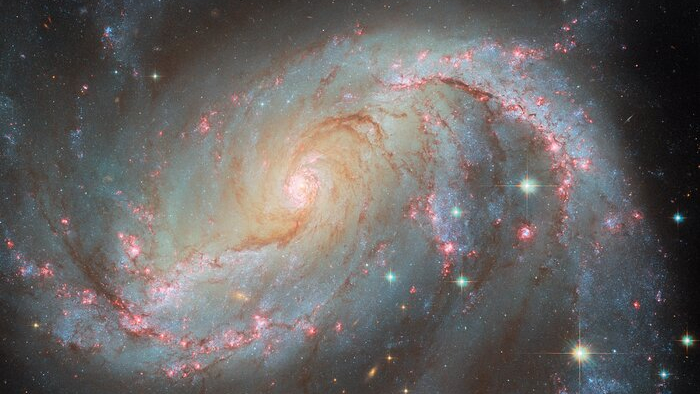
A celestial light show illuminates a distant spiral galaxy, where a hidden supernova briefly outshines its stellar neighbors in a new image from the Hubble Space Telescope.
The galaxy, called NGC 1672, is a barred spiral galaxy located 49 million light-years from Earth in the constellation Dorado. Billions of stars fueled by hydrogen gas in the swirling arms glow brightly across the galaxy, with newly formed and extremely hot stars emitting powerful radiation that creates a vibrant red light, according to a statement from the European Space Agency (ESA). (Hubble is a joint mission of NASA and ESA.)
The center of the galaxy appears exceptionally bright as a result of a supermassive black hole that lies within and consumes nearby matter, fueling what is known as an active galactic nucleus. Many hot young stars (the bright pink patches of light in the image) occupy the ring of gas feeding the galaxy’s central black hole.
As host to an active galactic nucleus, NGC 1672 is formally classified as a Seyfert galaxy. This type of galaxy is known to be incredibly luminous, with a nucleus that can shine as bright as 100 billion suns.
Related: The best Hubble Space Telescope images of all time!
"This galaxy is a multi-talented light show, showing off an impressive array of different celestial lights," ESA officials said in the statement. "Like any spiral galaxy, its disc is filled with billions of shining stars that give it a beautiful glow."
Data collected by Hubble has also revealed a live Type I supernova called SN 2017GAX, which can be seen tucked just below the crook of one of the galaxy’s two prominent spiral arms, near the bottom right of the image. This supernova is the most fleeting and temporary of the galaxy’s light sources, according to the statement.
A supernova is a bright stellar explosion triggered when a giant star nears the end of its life and collapses in on itself. It creates such a dramatic explosion that it can quickly outshine an entire galaxy.
In fact, Hubble observations of NGC 1672 taken less than a year apart showed SN 2017GAX beginning to fade into a smaller green dot. Of the six Hubble images used to create this composite view, the supernova is only visible in one, highlighting its brief nature.
ESA also shared a slider tool created using Hubble images taken at different times to compare views before and after the supernova.







